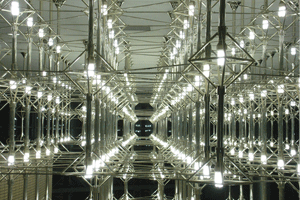You have no items in your shopping basket.
Battle of the Light Brigade: LED vs. Halogen vs. Sodium

The light source you choose will have a dramatic effect on visibility, as well as the atmosphere in your home or office.
When it comes to light bulbs, there are many to choose from. Yet three of the best in terms of efficiency are LED, halogen and sodium (which come in two forms). But which is best? Let’s take a closer look…
What are LED lights?
LED is an acronym of Light Emitting Diode. LED lights have been around for many years. They were once the high cost alternative to traditional fluorescent lights; but recently, they’ve come down a lot in price.
LEDs use semiconductor materials which are encased in plastic or glass. They can also be used in a normal bayonet or screw light fitting. When electricity passes through the semiconductor, this moves electrons (subatomic particles). This in turn produces light energy.
And they don’t produce infrared radiation; this means that LEDs are among the few light sources that don’t get hot to the touch.
What are halogen bulbs?
Halogen lights work in a very similar way to standard bulbs. In fact, they are pretty much an extension of that old design. In short, they rely on a chemical reaction between its tungsten filament and electrical current. Halogen bulbs are brighter and last longer than traditional incandescent bulbs, due mainly to a chemical reaction called a regenerative cycle.
What is a sodium lamp?
A sodium lamp uses sodium in an excited state to generate light. There are two kinds of sodium lamp: low pressure (LPS) and high pressure (HPS). Sodium lamps are very efficient sources of light; but the sheer yellow light they produce restricts them to street lamps and other outdoor uses.
Why is an LED better than a halogen or sodium lamp?
LEDs offer a wide range of advantages over both sodium and halogen lamps. Here are just three:
Colours: You will find LED lights in a wide range of colours; which is why many people use them on Christmas trees. Halogen examples produce a bright white light and offer no variation. As previously stated, sodium lights only produce yellow light.
Heat: LEDs don’t produce heat and don’t burn; unlike halogens, which can also raise the temperature of the room significantly. Sodium lights also heat up quickly, even at low voltages. This means that using LEDs is safer; and that there’s much less chance of an accidental fire.
Energy efficiency: Halogen bulbs use a lot of electricity to produce light; which can lead to high energy bills. Sodium lights are also highly-efficient; but they’re best as floodlights on the exterior of your home or office due to the intense light they produce. On the other hand, LEDs are great for many different purposes and use only a fraction of the power of halogen lights.
Long lasting LEDs can last for a staggering 60,000 hours. And while halogen and sodium lights do last a long time, LEDs dwarf them in terms of sheer longevity. In the time it takes an LED light to go kaput, you could go through as many as 20 halogen light bulbs.
